
One of my clients attended a Social Media Marketing forum at Deakin University recently. He was surprised just how out of touch most marketing and business managers are with this medium as a means for promoting a business. The questions being asked were about how to control staff access to social media or how to post their brands’ advertising and collateral across the newer platforms.
This top down approach where management dictates the agenda no longer cuts it.
In the same way the Internet has empowered the public to access their news, music and entertainment whenever they want, not when the distributers choose to roll it out, Social Media is taking the online quest for information about products and services away from publishing and brand sites. Social Media is creating a vibrant forum for conversation about products, services and brands beyond the direct control of a company’s sales and marketing force.
The statistics show the rapid pace of change of where people are going online in search of information of all kinds.
Trend away from website visitation to Social Web
Google trends show over the last 2 years a significant decline in visitors to brand and media sites.

Boom in Social Media and content sharing
More people are seeking and sharing what they want online.

It’s no longer enough to have a brochure style website, you can no longer sit back while your salesforce distributes your marketing collateral and your marketing department runs ads telling the masses how good you are.
Everyone in your organisation and every one of your customers is now a prospective advocate for your business. Or they might be saying your competitors are better. You can’t control the conversation, but to compete today you need to formulate a social media strategy, coach your staff, create content of use to customers and prospects and contribute to the conversation in an open and honest way.
Small can succeed in retail against big budget incumbents
Growing up in sixties suburban Sydney the most exotic cuisine my family was familiar with was cabanossi on Jatz crackers. Father felt like a Tooheys or two and good on my mum, she knew Tip Top was the one. Fortunately, forty years of immigrant mothers from around the globe have helped expand Australians’ culinary horizons.
Family businesses show how to be a challenger brand
At the Food and Wine Expo held by Family Business Australia in Sydney in November, the influence of Nonnas was evident as third generation business owners showcased their gourmet products. Their time has come, statistics show the trend to gourmetisation of the Australian shopping basket has now reached beyond the specialist deli and ethnic store to the Supermarket.
Unlike most trade shows, what struck me at the FBA event was the friendly atmosphere, no hard sell, just an infectious enthusiasm for the products these families have been creating for years and a desire to share business stories. From the small catering company making their first tentative step into retail, through to a food service business that gave up on retail in the 70s, one story is common: the bigger challenge isn’t getting onto the shelves of Coles and Woolworths, it’s how to stay there and make a profit.
Two family businesses, Taylors Wines and Coopers Brewery, are testament to the magic ingredient for success in the retail market – the power of building a brand. Branding is what puts the power in your hands, not the channel’s. Building a brand takes more than one-off promotions, or advertising that simply says you are in store now, or paying for inclusion in catalogues with discount offers. To build a brand you need to invest in marketing over time to establish the brand story and your values.
Brand marketing delivers these benefits over a me-to sales approach:
Product
Easy to copy
A commodity
No special distinguishing features
What a factory produces
Shorter life cycle
Addresses functional needs
No identity
Products compete on price
Brand
Hard to copy
What consumers buy
Emotional fit with consumers
Level of confidence and trust
Longer life cycle
Addresses emotional needs
Have personalities
Brand can demand a premium
Fosters Group has destroyed shareholder value to the tune of hundreds of millions of dollars over the last decade by mismanaging the marketing of some icon wine brands, from Lindemans and Penfolds to Seppelt and Tollana. Meanwhile, family business Taylors Wines has stayed true to its five decade history with consistent product, packaging and promotion.
Nick Levy, the marketing manager at Taylors, wouldn’t dream of throwing out the heritage of this family business, whereas corporations time and again allow each new brand manager to make their mark by changing the label their customers know and love to chase a fleeting fashion. Often the new look comes at the expense of long won recognition. Similarly, downgrading a product’s quality to maintain margin or constantly price-cutting to gain share ultimately destroys brands.
Yes, we live in a time where the pace of change is so much faster, yet taking the time to establish what you stand for, developing a dialogue with your customers and creating a sense of authenticity are increasingly valuable tools in a world where global producers can pitch to your retailer with a cheaper knock off product as soon as you leave the buyer’s office.
If you value what you have to sell, it pays to remind your customers as often as you can of why they should love you. Now you can afford to. New technologies, data intelligence and eCommunications now enable challenger brands to compete successfully with the large advertising budgets of corporations.
So find the true benefit of your offer and actively market it. As Revlon said, having built an empire with brand marketing, “we don’t sell cosmetics, we sell hope.” Worked on my mum.
This article first appeared in Business Insight
Leave traditional marketing to your competition... Now there are smarter ways to connect

To make the most of a marketing budget there are now smarter ways to integrate social media and search optimisation.
Many struggle to keep abreast of the changing landscape, while companies that take advantage of 'eCommunication' will benefit from increased efficiencies, decreased costs and improved customer engagement.
Traditional marketing funnel view of prospects...

Medium and message is aligned to where the audience is in the funnel, information is controlled by the brand.
The decision making process in an e-connected era...
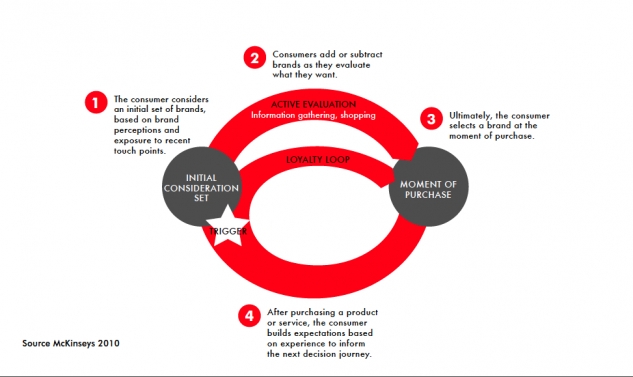
Time to replace the old touchpoints with a new mix
The journey is no longer simply linear, the customer now has control over what they see and read on any subject. The audience enters, leaves and re-enters the decision making process more often, with more access to information from more sources when they want it.
Your eCommunications checklist
Whether your business is B2B or B2C, it’s no longer enough to think in the linear way of out of home, in store (channel), at home. Here is a new set of options which UNO utilise to supersede or integrate with existing programs:

Are you a retailer or publisher, advertiser or educator? The Internet has blurred the lines.
There used to be clear delineations between product manufacturer/creator, channel/distributor, retailer and end consumer.
Enabling this traditional marketing model there was mass media. Advertising mad men then helped consumers to embrace the products and services they hadn’t heard of and didn’t know they needed. Now the interconnections of the Internet have transformed the sequence of commerce and marketing.
Customers are now researching every category online
People have a need? They research online for themselves in the safety of their own home, avoiding the charms of advertisers and brand collateral, packaging and point of sale merchandising. The empowered consumer accessing product knowledge on the web via forums, chatrooms and reviews is beyond the charms of the seasoned salesman on the shop floor.
Even more disconcerting for the traditional retailer of a product or service is the emergence of the medium no longer just being the message, but now a vertically integrated marketing model.
From books to money management, every category has been turned inside out and upside down. What was linear, is now a 3D demand and supply freeform organism.
Consider books. A hard back would come out, early adopters would pay a hefty premium, soft cover would follow, trends would be noted, popular titles would have second and third editions printed and distributed, blockbusters would be advertised and the retailers would rake in the cash and the publishers would cover the costs of the many failures by most of their authors.
Then Amazon cut out the middleman, and now with the Kindle is changing the distance from content to delivery even further, you can now download and store a library of 3500 “books” on a device that is close to the price of a couple of hardbacks. So if there is no need to print and distribute, does the author deal direct with Amazon, seeing the retailer become the publisher?
Even services aren’t untouched by the digital revolution
Take for example Superannuation Funds. If you work you have one, no wonder there are thousands of funds competing for a share of 9% of your salary.
For Australian investors there used to be 3 Clayton’s choices, the choice you have when you don’t get a choice. If you were a blue-collar worker your employer put you into the Industry Super Fund that was created for your industry. If you were a public servant, you were automatically in your government fund. White-collar workers had a modicum of choice, the local Insurance salesman would flog a retail fund and benefit from the handsome commission and trailing fees.
Not any more. Super Choice means most can now choose their fund. Those who are motivated research online, in fact 50.6% do, whereas only 12% turn to newspapers and a mere 3% magazines. So while all those funds are spending hundreds of millions advertising in mass media, savvy investors that are shopping around are stumbling upon a vertically integrated model. Fairfax Digital owns InvestSmart, a licensed financial services business that bought Direct Access, which was a discount retailer of funds. Fairfax in its wealth and business sections publishes articles on super and investment. On the same pages are links and comparison tools branded InvestSmart. These tools and tips and comparison lists educate the Super Shopper. Then when they are ready to buy, fulfillment is just one click away for a fee a fraction of the traditional adviser model. So the publisher becomes the retailer.
So does all of this mean consumers are better off? The fastest growing and the biggest segment by value of the 1.4 trillion dollar Super category is DIY. Self Managed Super offers investors the allure of control. Pity the average SMSF underperforms the average Industry Fund and has higher costs, until someone challenges the model that is.
Whether you are a retailer or a service provider, a financial services business or a manufacturer, it’s now time to reappraise your marketing model before your competition beats you to it.

Marketers have spent the last decade watching Woolworths maintain dominance in grocery while Coles failed to focus on customer needs and treated suppliers with disdain. Under Wesfarmers things are starting to change, yet the biggest fight in retail over the next decade is more likely to be driven by a huge shift to buying online.

While Australia’s Westfield has over 30 years fine-tuned a profitable model to encourage a visit to the Mall, as therapy for the modern empty soul, the Internet is on the cusp of changing the behaviour of society in an equally profound way.
It’s already happening. In 2009 Australians spent $24billion on retail online according to research commissioned by eBay and predicts a 40 percent increase to $32.8billion in 2012.
Australia’s retailers are falling behind the rest of the world in grabbing a share of the online retail spend. "As Australian retailers struggle to build effective online presence, overseas competitors are taking advantage of the gap in the Australian market and are currently taking around 40 per cent of Australia's online retail spend," according to PayPal MD Paul Feller.
"There is a huge opportunity for retailers to capitalise on the growing online marketplace in Australia. In the last six months alone the average consumer spent $1,223 on online shopping, an increase of $130 from the second half of 2009."
So Westfield has to balance an online strategy with keeping footfall high in the malls to keep those retail tenants in biz. No easy task, now that broadband speeds and speed and reliability of delivery through the mail are narrowing the gap between online purchase and the wardrobe.
Who shops online?
My daughter buys most of her clothes online from the US and UK for a fraction of local prices, my son buys his music and sound gear from all corners of the world and Amazon keeps my partner well read. Online purchases of all sorts of items will become the norm, especially as the ways to enhance the shopping experience online grow.
In the past you would see the latest fashions in a magazine spread, be exposed to an ad on TV with Megan Gale for David Jones and go the mall to try it on. Now the whole experience can be completed online. The Ceros platform is being used by the likes of Sears, Tesco, Virgin and IKEA to show product and close a sale using a rich media eMagazine. Have a look. We’re already using it to help our challenger brand clients leave their competition behind.
Read MoreMarketing tips for fund managers
Fund managers can make more money by marketing. The trick is to know what marketing is exactly...
I have a passion for following fund managers’ performance and comparing how they stack up against their investment philosophies. There are a handful of fund managers who stick by their principles and deliver above average results through the ups and downs of the markets. What surprises many managers is that investment doesn’t always come flooding their way when they are doing better than the index. There are plenty of examples where poor performing funds continue to dominate in the competition for FUM.
It’s not enough to rely on BDMs and the distribution and sales channels; every fund is out there building relationships with the instos and advisers. The commercial reality is rooted in human nature; ultimately the salesmen who managers are relying on to recommend a fund will go for the easy sell. And as we’ve seen, performance can’t be the only draw card or there wouldn’t be 19,500 funds on the market where the biggest generally aren’t the best. It would be a mistake to think the end of commissions will result in a rush to quality, inertia and confusion will see to that.
It’s time the better managers tried something new to most in the industry. It’s what’s been honed and crafted by the world’s most successful companies, from Apple to Armani, Mercedes to Mars: it’s marketing. In a world of multiple choices, marketing is one of the few tools that can make a significant contribution to the success of a business.
The financial services industry still confuses sales and distribution for marketing
It isn’t. Marketing takes the ball the first fifty metres and sales kick the goal. Then it’s marketing that continues to remind investors why they made the right decision choosing your fund, so they’ll stick by you through the inevitable bumps and falls. And invest with you again and again.
In the words of Wikipedia, marketing is the process by which companies determine what products or services may be of interest to customers, and the strategy to use in sales, communications and business development. It is an integrated process through which companies create value for customers and build strong customer relationships in order to capture value from customers in return.
Manage the image you create for your brand and how you promote it
From product design and the language you use, your logo and stationery, the look and imagery in brochures and PDSs, the content and design of e-newsletters, what is on your website and how it is presented, to advertising and sales collateral. When every part is working together in a co-ordinated fashion the whole adds far more value to the business than the investment in the parts. And just like investments, managed well marketing delivers compound returns.
Over the years I’ve found integrated marketing works just as well for financial institutions as it does for baked beans. Research by the School of Management and Finance, University of Nottingham showed back in 1998 the similarities emerging even then between consumers’ responses to financial services ads which featured the same cues as ads for fast-moving consumer goods (FMCG) and the influence on subsequent purchase decisions.
Put simply, when it comes to proven ways to make money, fund managers can get a healthy ROI from marketing. For evidence, they just have to ask about the results of my many marketing experiences of 30 years, from banks to baked beans.
Signs of the times... who has the time?
Outdoor advertising is diminishing in effectiveness, like many traditional mediums
Not surprising when you think about the increasing clutter advertising billboards have to compete with for attention.
In the Drive section of the SMH the other day one motoring journo observed: “I went to a suburban shopping district and counted 19 road signs clustered around the first intersection. There were 55 road information messages in about 100 metres. Even when travelling at 40km/h you are left with just nine seconds to read them". In the book Traffic, Tom Vanderbilt states the average driver must process 1340 pieces of information every minute.
So recently when a client asked UNO to review their annual advertising media budget we weren’t too keen to recommend continuing to spend several hundred thousand dollars for one poster above the M4.
Old habits die-hard, the CEO drives to work each day and passes that one sign. We couldn’t convince management that for about 20% of the cost of that one sign they could develop an ongoing relationship with their customers using the latest Web2.0 technologies and build a valuable database for future use.
While traditional media companies like Eye Corp continue to sell posters, a medium that hasn’t changed for a couple of centuries, newer more effective alternatives are emerging. (When the price is right.) ROI marketing starts with understanding the real stats.
Innovation in signage
Recently Ryan Simpson of Val Morgan showed me the latest research on their innovative take on signage, large video screens in shopping centres.
While I always take statistics with a grain of salt, the figures reflect the relationship between clutter and proximity to where the purchase can be made. Despite the amount of billboards, busbacks and taxibacks that shoppers must have passed on their way to the shops, almost 50% say they didn’t notice any advertising. 30% remembered noticing billboards, whereas this new moving screen medium within shopping centres was noticed by over 70% of the 1,000 people surveyed by Nielsen research.
Pity I didn’t have those sorts of stats on hand when I tried to talk that client out of spending a large chunk of their budget on that one sign.
Bigger ad budgets usually mean greater waste
Marketers don't always get what they pay for. I recently met with the new regional head of one to one marketing of a world leading brand. One to one is their fancy term for online. This new manager has been brought in from the USA to determine how the millions of dollars they spend annually in this region can deliver a better return.
Mid size companies can learn from the mistakes of larger marketers with larger budgets. Some of the areas of waste this expert has identified in just a few months are listed here:
Marketing budgets managed within silos is inefficient
Some products have budgets too small to make any impact, while others spend more than necessary because they have a larger allocation. Simply by adding an overview of expenditure across the portfolio would deliver a win win result.
Too many contracts with too many large agencies can drive a big spending approach. Marketing managers with little experience are often given average strategic advice and average creative executions. Large agencies are inclined to overspend on media exposure, (with commissions it's an easy earn).
Set marketing KPIs upfront
Smarter marketers know investing in more management time upfront determining objectives and KPIs, with strategic intellect and strong creative can mean a much smaller media spend can deliver greater impact, more leads and higher conversion rates. There is also an inevitable diminishing return factor from spending more, if someone sees your ad two or three times and still hasn't bought, spending more to show them the same proposition four or five times is simply a waste of money.
There is value in retained knowledge
Years of collected data, research results, campaign learnings and customer databases are often ignored with each new project. Every campaign can and should add incremental value to the next. Take a test and learn approach, rather than a big spending one-off hit. This is one of the fastest ways to implement ROI marketing.
Fortunately for my mid sized clients, I've found over the years insight led creative marketing can punch above it's media weight time and again.
Read MoreGM a victim of launch and leave
For General Motors, big has not proven to be better. From 50% market share to 20% and bankruptcy in just 40 years has partly been blamed on an inability of management to move with the shift from big gas guzzlers to smaller cars. The disastrous purchase of Hummer in 1999 showed how recently GM thought big still had a big future. Time has proven there were only a few big spenders like Renee Rivkin who bought these massive buckets of bolts, obviously not enough to pay the massive borrowing costs.
Less obvious to the public, and of more interest to marketers, are the views being expressed that a lack of advertising support has played a very significant role in the rapid market share loss to the Japanese car makers.
One example was the surprisingly upbeat statements by the head of marketing of GM, he is excited by the prospect of having less brands to support with his marketing budget. With the jettisoning of divisions like Pontiac, he'll be left with just four brands to promote, including Chevrolette and Cadillac. This he trumpets will give him a chance to compete with the same ad budget as Toyota.
In an obituary of the once market leading General Motors, The New York Times blames management for a failure to support it's product with advertising.
Advertising works, The New York Times says so
It points out GM finance staff wrestled with product developers and marketers, thus causing GM to fall victim to a practice called launch and leave - that is, putting product on the market, then failing to support them with advertising.
As someone who has played a part in helping numerous businesses grow share by using smart, creative advertising, this is a particularly public example of the consequences of not believing in the power of marketing. If you ever have to justify to management the wisdom of investing in advertising, when so many accountants seem to view it as a discretionary cost, use this following quote from a past executive of GM who was part of the team that created the successful Pontiac GTO in the 60s and wrote the book about it Glory Days...
Image is everything in building brand equity
Nobody gave any respect to this thing called image, because it wasn't in the business plan. It was about "when is it going to earn a profit?"
As the New York Times points out, over the years the marketing skeptics at GM became practiced at the art of explaining their problems, attributing blame to everyone but themselves.
Read MoreIt pays to trust people with passion
In the last week a visit from a chimney sweep and a conversation with a successful Australian manufacturer reminded me of the value of passion in business.
I was surprised when the chimney sweep asked when was the last time my chimney had been cleaned. Annually didn’t make sense to him judging by what he saw with his fancy mirror... unless I burn 20 tonnes of wood a year, which I don’t. I was quickly impressed by his enthusiastic run down on the finer points of proper chimney maintenance. This man has been cleaning chimneys for 27 years and was still getting a buzz from helping people solve their dirty flue problems, he described the joy solving more difficult challenges and leaving customers with fires that draw like new. His fee was no more than the company that has under serviced us over the last few years.
Whatever service you need, find a practitioner who is passionate about what they do
One of my long standing clients, going on nine years now, makes plantation shutters. Marion Mikkelsen of Open Shutters is passionate about her product, and has built a brand over this time that has proven resilient against the onslaught of cheap Chinese imports. She is so passionate every aspect of her business is constantly reviewed with the objective of constant improvement. She refuses to compromise, so instead of cutting corners to save costs this business runs on a successful program of creative thinking, R&D, staff training and manufacturing innovation.
This passion shows in her product, which my wife thought was the best when she did her pre-purchase research for our home. It was only a few years later I coincidentally won Marion as a client... it is great to be able to market a product you’ve bought yourself.
Why do so many business people mistrust each other?
Over 20 years this pioneer of timber shutters in Australia has led with product innovation and with UNO’s marketing help driven the growth of the category. Yet Marion lamented this week how it’s only after many years her distributors are beginning to trust what she says about her product and her overarching belief in the necessity to fulfill the expectations of consumers. How could so many small business owners not recognise the genuine passion displayed by Marion?
I shouldn’t be surprised, I often find business prospects are cynical of what I have to say about how smart marketing can help their businesses succeed. I’m passionate about what I can do to help people, however it’s even harder to be believed when I work in an industry that the public constantly ranks at the bottom of the trust table alongside used car sales and real estate agents.
Read More

You may have noticed late last year the AANA broadened their official definition of “advertising” beyond that of a paid-for message. To reflect the changes the Internet has brought about, they now refer to “marketing communication” activity as brands are now often engaging in two-way conversations, not just pushing messages one-way via ads.
Early this year CommBank’s CMO Andy Lark, an ex PR man himself, told PR agencies they risked losing their traditional area of expertise to digital experts and integrated agencies.
The issue for businesses isn't simply which external supplier or internal staff is running your social media. With new technology comes a lack of control over how customers choose to seek information and engage with you, which brings a new level potential for confusion. And just as there is confusion around whom within a company or it’s preferred communications partners should be in charge of the conversation, the laws we all operate under right now are equally confused.
Who is responsible for comments posted on your business Facebook page?
In response to an ACCC ruling and fine of a liquor brand for leaving comments on it’s Facebook page deemed to he inappropriate, the AANA extended the reach of its Codes to cover most forms of advertising and marketing communication over which the advertiser or marketer has a reasonable degree of control.
In two recent determinations dealing with brand-owned Facebook pages, the Advertising Standards Board (ASB) reflected the AANA’s intent and stated:
“The Board considered that the Facebook site of an advertiser is a marketing communication tool over which the advertiser has a reasonable degree of control and that the site could be considered to draw the attention of a segment of the public to a product in a manner calculated to promote or oppose directly or indirectly that product."
"As a Facebook page can be used to engage with customers, the Board further considered that the Code applies to the content generated by the page creator as well as material or comments posted by users or friends.”
While you may think this ruling is a bit rough, at least you know where you stand. Until this week.
The AANA at least gave clarity, we now have a contradictory new set of guideline by the IAB
“After a careful analysis of existing laws and regulation and industry practice around social media IAB Australia has reached the view that user comments directed towards an organisation or social media platform, or to other users who are drawn to a particular organisation, do not constitute advertising,”
According to Samantha Yorke, director of regulatory affairs at IAB, “There is a real risk that organisations who treat user comments as advertising will err on the side of caution and moderate user comments very conservatively, which will adversely impact their presence on social platforms and which arguably undermines the very spirit under which social media thrives,”
I wonder what a judge will say about a marketer’s immoderate management of a social media campiagn in a yet to be held ACCC hearing?
UNO is one of a small number of marketing communications agencies accredited by The Communications Council of Australia. We believe self regulation only works when all of our customers' messages within our control are held to the same highest standards of paid-for and signed-off ads, irrespective of whether published in a traditional, new or yet to be invented medium. At least that way our clients have minimised their risks, both known and unknown.
Read More
There are many tips and how to guides claiming they have the key to revealing the relative strengths and weaknesses of where to advertise, promote and connect. Media sales reps have a long history of presenting charts and graphs that show their medium in a favourable light. To ensure the best ROI marketing, we only rely on those studies that have rigorous methods and meaningful numbers to make the findings reliable.
Don't trust every media benchmark you can Google
For those who want to know what medium is most effective at acquiring new customers in the digital era, here is a chart we feel is valid:
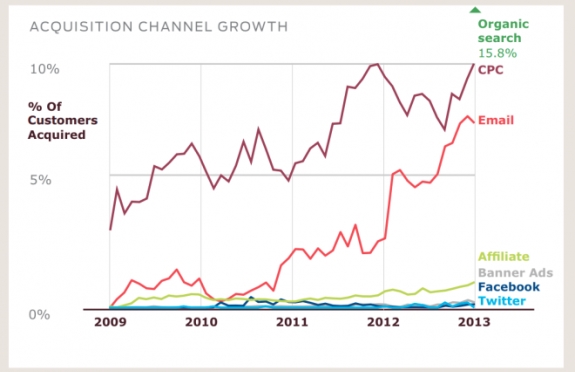
Trend in performance of digital channels for acquiring new customers
Custora came up with these figures by analysing data from 72 million customers shopping on 86 different retailer sites. They tracked where customers were clicking from (email, Twitter, Google, etc.) and what and how much they bought, not just on that visit but for the next two years.
Over those two years, Custora found that customers who came to retailers from search were 50 percent more valuable than average. In other words, they were more likely to shop more and spend more. Email customers were nearly 11 percent more valuable than average. Customers who came through Facebook were just about average. Twitter customers, meanwhile, were 23 percent less valuable than the average during the two years following that first click.
I've written before that our reluctance to spend clients' money on banner ads is based on one amazing fact: you are more likely to win Lotto than click on a banner ad.
In comparison to these digital channels, research by the Direct Marketing Association shows you may still be best served with good old direct mail:
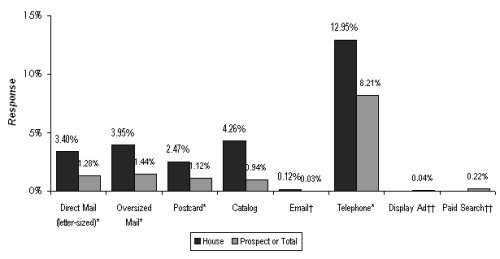
Average response rates for direct sales, DMA 2012
There is one new piece of research though that ultimately makes the discussions about differences between media effectiveness become a secondary consideration. It's proof of what many of us have always suspected.
How you craft your message is more important than the medium
The latest research into advertising effectiveness in Australia has proven creativity makes a big difference. The Association of Data-driven Marketing & Advertising shows that after 12 months ads with better ideas are both more effective and increase a brand's ability to harden pricing.
This reminds us you’re potentially wasting your time and money if you don’t get your pitch right. As consumers we remember big ideas, like “Think small.” Or the pulling power of a well crafted headline like “It’s Time.” Or a picture worth a thousand words...
The truth well told has been proven yet again to be more important in getting the best ROI from your marketing than any optimisation techniques digital specialists may dazzle the bean counters with. We are not animals, we are human, and we respond to emotions, not numbers of targeted exposures.
For those who want to make the most of their investment in airtime/space/or face-to-face, remember to invest a little in the art of communication.
It's not just consumer brands that can benefit from better communication
An ability to express your message is just as impotant for both service businesses and B2B. This is especially true for financial services, as shown by this chart of what customers say are the most important qualities in a financial adviser.
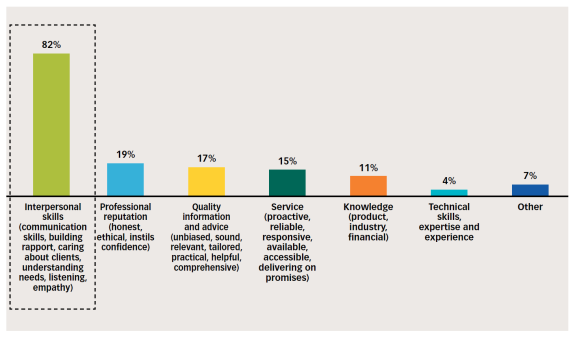
AFA White Paper: The Trusted Adviser May 2013
The report found the biggest difference in success of the top 10% of financial planners and the rest isn’t expertise, or credentials or technology – it’s the ability to communicate. Communication is not talking at people, it's the art of speaking with empathy. This is where social media excels. Use it to listen to your customers, then respond in a way that makes the individual believe you understand where they are coming from.
Irrespective of digital or traditional, face-to-face or in writing, where you have the conversation is secondary to the way you express yourself.
Just remember to make the message suit the medium. Our burping cow ring tone for Sipaah was downloaded by lots of kids who knew exactly where our brand was coming from.
Read MoreFame is the game of the name


The exponential pace of change is increasing the pressure on businesses to stay competitive. You know it’s not going to slow down. Fortunately there are still ways you can take control. One proven method is to revisit some simple building blocks to help make your brand relevant in today’s complex marketplace.
4 step process to make a challenger brand famous:
GAME
NAME
FAME
CLAIM
Game:
When did you last define what it is you do you do that makes you a specialist. In a cluttered business environment it pays to play in a defined niche where you know more about the rules of the game than your competition. Define the things that are of value to your prospect. Make sure you understand what it takes to be world’s best at your game, and work to stay at the top. People will still pay you a premium for something special that means something special to them.
With a fresh outside perspective, define your true differentiators, your “authentic truth.”
Name:
Your reputation, the brand and everything it does must be aligned with what you do that is special or your efforts will be diluted. Today, any business with integrity can compete against established incumbents. The cost of entry is no longer big budget mass media campaigns, the spoils now go to the nimble.
Today, the truth is what counts, the public can find the facts faster than businesses can attempt to shape opinion. Ensure your brand reflects your truth in everything you say and do.
Fame:
The art of being noticed. And remembered. And talked about.. You can do this several ways. Spend a lot of money, like Swisse, who invested up to 60% of annual revenue to marketing to achieve business growth, which stands at about 50% year-on-year over 4 years.
Or take the stand out in the crowd approach. An elevator pitch is only of value if people are listening, be too polite and you will be invisible. There is something to be said for the fart in a lift approach, however can you risk going viral with the wrong tone of voice?
Ideally, you can take the hero approach: be noticed by the right people for the right reasons. To do this ensure you choose the right medium for your message. There have never been so many communications options – a pitfall for the unwary, and an opportunity for the savvy
Claim:
Tell the truth, especially now the customer can search the Internet to discover what is a genuine claim and share with their friends what they find out. Decide what will differentiate you in your game – do you do it faster or smarter, cheaper or better?
Then find a creative way to express your difference. As J Walter Thompson said almost a century ago, “the truth well told” is the value add of great advertising.
Famous campaigns start with a defined customer benefit
What’s your “Which Bank?” How will you enter the vernacular, as this one of mine did 25 years ago:

With a creative leap, you can express the human insight that will resonate with your prospects. And they’ll repeat it to friends, again and again.
Read More
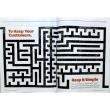
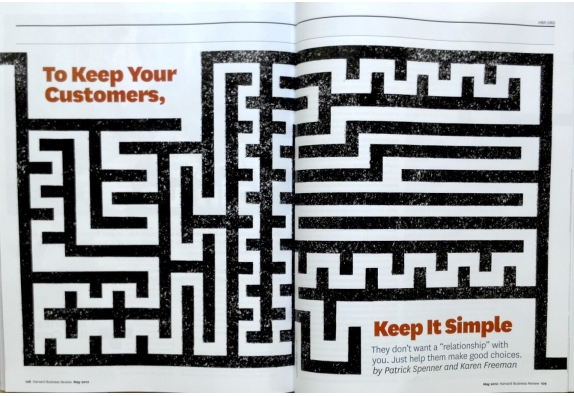
How do you explain to the manager who signs off your budget that today customers want more from your website than a brochure online? You can start by pointing out how you can replace existing fixed and recurrent costs with keener priced digital alternatives. Then remind the cost controller that technology is moving so fast they’ll be surprised how much more you can do today for less. A lot less than many of the savings to be made across existing business practices that digital can now enhance or replace. This 12 point digital checklist can help you keep it simple and the returns substantial.
Your digital project 12 point checklist
Keep an open mind, what the site needs to include is based on what the customer wants, don’t limit scope by prescribing whats to be included by your what your preconcievd ideas of what the competition have already done.
Engage with the user in the context of where and how they are accessing you. Are they on a mobile while in a shop, in bed on a tablet or at their workdesk on a PC? At work, at home, on the move, your site experience needs to change accordingly.
Educate or entertain? Ask yourself are they visiting your site to learn more, or simply because it is an enjoyable experience? Or would they like it if you did both? Deciding this helps shape your content and navigation.
Personalisation. "Allow users to personalise their experience. People love to add personal touches because it helps them feel at home and in control. Provide sensible, beautiful defaults, but also consider fun, optional customisations that don't hinder primary tasks." - Google Android
If you don't treat each customer as an individual, a competitor will. Technology now enables you to serve each visitor exactly what they want, a bespoke site just for them.
Innovate.The digitisation of everything now allows you to reinvent so many of your business functions and methods, take advantage of what is now possible.
Tone of voice is more important than what you say. The way the site looks, the colours used, typography, whether there are pictures or videos and the style of vocabulary you use will make a bigger impression about your brand image than what is in the text.
Services is what you build today, not websites. "Our service doesn’t begin and end at our website. It might start with a search engine and end at the post office. We need to design for that." - GOV.UK
Iterative, our most used word to describe our process for scoping, designing and building a digital service. Start small, constantly evolve and develop the service offer. We learn and improve the offer together as we go.
Marketing. A site without marketing is an island resort that’s not on any map, let alone an itinerary. Don’t launch and leave, have a plan that will drive customers and prospects to your site, align what the promise is and how your site will deliver to expectations.
P, there are 4 of them in marketing: Product, Price, Promotion, Place. Consider which of the Ps is most useful to enable you to best engage with each type of customer. The 4Ps of marketing aren’t all the same for every person or every occasion.
Load time is more important than looking good. Too many fancy things can slow down the experience.
"Make important things fast: Not all actions are equal. Decide what's most important in your app and make it easy to find and fast to use, like the shutter button in a camera, or the pause button in a music player." - Google Android
Effectiveness. Know what you want to achieve and why. Most importantly decide how you will measure with meaningful metrics that can be acted upon. Then you can build in measurement techniques to track what is working and what needs to be improved. And make sure someone is in charge of tracking results and implementing improvements.
If in doubt about what matters most, remember the customer's perspective comes first. Look at the first letter of our 12 points. In an increasingly complex world, when you connect with customers they will appreciate it of you can KEEP IT SIMPLE.
Read MoreRadioactive ads from when people didn't know better

Classic ads from 1910-1930 for radioactive products
What can’t radium cure? A century ago it was legal to advertise radioactive products, from toothpaste to suppositories, condoms and check out the chocolate!

If looks could kill: Radium lipstick advertisement from the 1930s. (via 109.com)

More classic ads from the 1930s for the Tho-Radia range of makeup.

Nil by mouth, guaranteed harmless?!! Gives new meaning to "the ring of confidence"

Anyhow, have a radium.
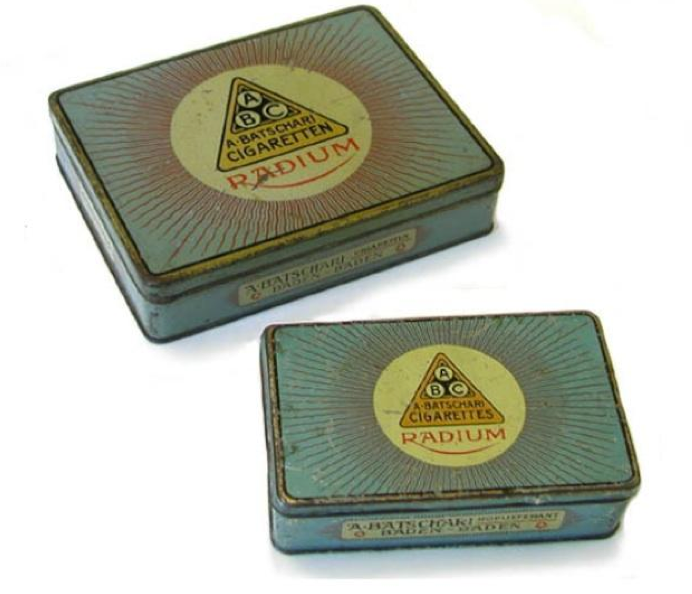
Now in a convenient pocket size pack of 20s. They didn't know smoking kills.

Mrs Marsh could give us a demonstration of the brighter effects on your smile of Radium toothpaste.

Chockaholics aren't left out, Radium is everywhere. The ads claimed eating a block would make you look younger.

Time wasn't on the side of those with radioactive numbered watches that glow in the dark.

Another ad campaign competing for share of the toothpaste that glows market, now with added thorium.

Radioactive wool keeps you warm on the slopes.
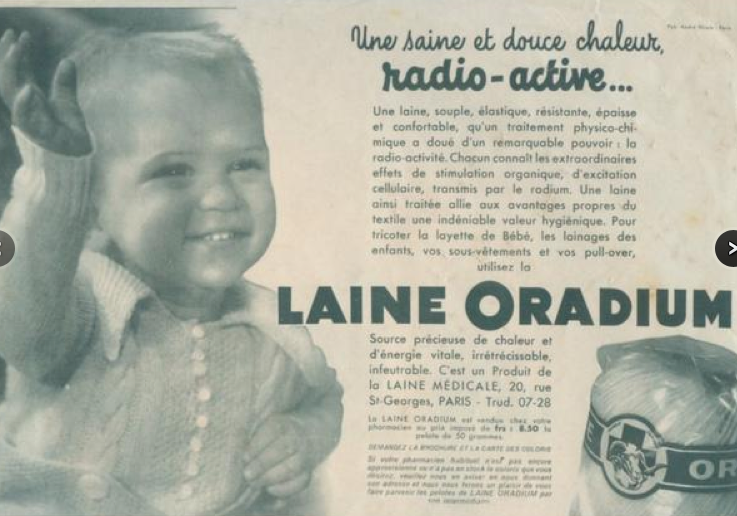
Dress your baby in it.

Advertised as a cure for arthritis, rheumatism, mental illnesses, stomach cancer and impotence. (via Real Food University and Oak Ridge Associated Universities) Triple distilled, who needs a whickey chaser?
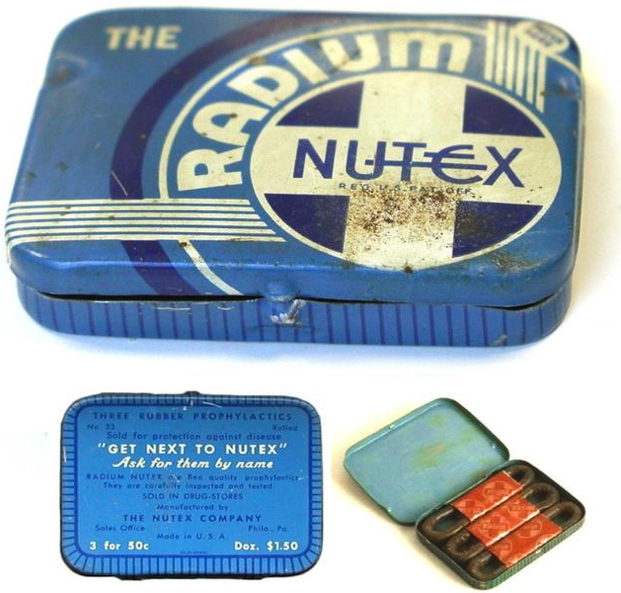
Condoms, that glow in the dark?
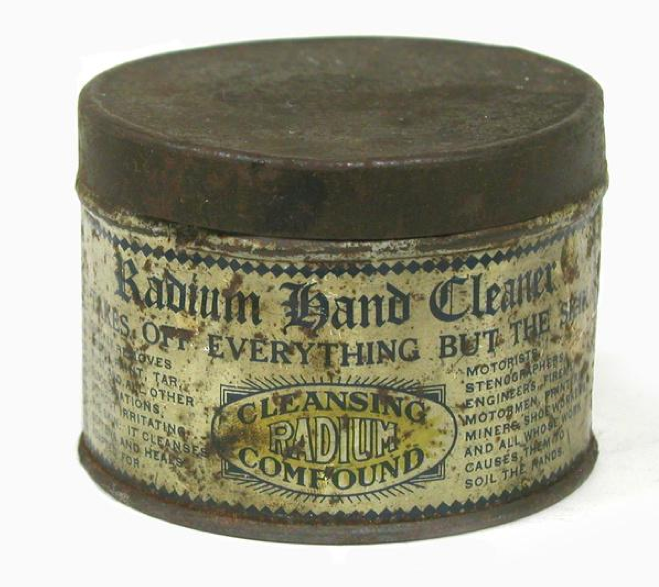
They didn't realise you can't wash off radiation poisoning.

Dr Curie started something big. Cosmetics companies continue to claim they have the secret to eternal youth.
Like to see some more classic ads?
Have a look at 12 great vintage politically incorrect ads for Christmas gifts.
Read More

Everyone knows the way to lose weight is to eat less and exercise more.
Yet year after year most Australians are getting fatter. Fatter people aren’t as healthy. Fatter people die earlier than fitter, leaner people.
A whole industry makes money out of fat. Fitness clubs. Personal trainers. And diets. None of it works over time. The stats prove it. It’s not enough to know you have a problem. Personally I have never been better educated, yet I’ve never been so overweight.
Science has shown only cognitive behavioural therapy ensures long-term positive change and a healthier longer life as an ex-fatty. 21 days of mind reprogramming is just the start to breaking the usual fatso habits.
Business as usual doesn’t work. How long till the business you work for dies?
Australian businesses are fat. They aren’t fit enough to cope with today’s rapid pace of change and increasingly complex issues. They don’t exercise their brainpower by trying something new. And like most of us with a weight issue they are looking for the quick fix. So they outsource it.
The diet industry equivalent in this instance are the service providers, from the Deloitte pre-prepared meal programs and the peddlers of management boot camps, to the efficiency fitness trainers selling the benefits of Sigma 6 and Lean. Even the language is the same as The Biggest Loser.
The answer for struggling businesses isn’t in doing the same things more often, or paying more personal trainers to lift your motivation. Nor is it enough to reduce the excess fat by cutting costs. Stomach stapling the business results in staff suffering reflux, hunger pains and mental stress for no performance improvement.
The answer is cognitive behavioural change.
The answer is developing an innovation mindset.
Here’s how it works and why most businesses are doomed to die early.
It starts with the owners of the business recognising they have a problem. An attitude problem. Their brains have been thinking the same way so long their synapses have turned a well-worn groove into a rut of superhighway proportions. The problem is, it’s now a road to nowhere.
The new business opportunities aren’t where the brain has become accustomed to drive to, every category is seeing their marketplace become a ghost town. Today’s marketplace is somewhere new, and management not only don’t know where it is they don’t have a map to show them how to get there.
The new destination is growing, profitable and exciting. It’s enabled by the Internet and feeds on new ideas made possible by software as a service, unified comms and the cloud. The new place isn’t a city or a country or a category, it’s everywhere and anywhere the customer happens to be, 24/7. Now every customer or prospect can pick and choose what they want via a mobile device. From cat food to cars, retirement plans to restaurants, you can research and purchase without talking to a salesperson.
Yet business owners continue to think the value of their business is existing fixed assets and legacy systems, current supply contracts and distribution arrangements, proprietary processes and procurement systems. Australian managers continue to tweak a little here and there around the edges of their business models. Generally, the bigger the organisation the more cholesterol blocked the arteries of internal management and external communication.
Figuratively speaking, fat dead men walking the corridors of offices around the country are about to be knocked off by fit and nimble female and new age male entrepreneurial thinkers who are open source and open minded.
So what do our business leaders do? They buy another diet book, like the biography of Steve Jobs. What they don’t realise is reading about Apple is as relevant to middle managers as middle aged men reading about Usain Bolt’s exercise regime. Apple was a challenger brand from day one. It was in the DNA.
The answer isn’t reading a book on what someone else has done. It comes from doing what hasn’t been done. It comes from the confidence to try something new with a willingness to fail. Accepting you’re likely to fail again and again. Because continuing to do what you do now is guaranteed to fail. While with every new thing you try your chances of discovering a winner increases.
Changing your habits and practicing to do what doesn’t come naturally, every day, is the proven method for success. It’s making a habit of taking small risks often so you don’t stand still and become another Kodak. The proof is in understanding how Fujifilm could innovate itself a future as a cosmetics company.
Memories might be priceless, they just don’t make money like they used to.

How a traditional business became a challenger brand
Fifteen years ago Kodak entered a death spiral, from a global peak in 2000, camera film sales dropped 90 per cent in 10 years as the digital revolution swept the world. “We’d known it was coming since the 1980s,” says Yojiro Yamashita, general manager of Fujifilm’s life science products division.
Kodak didn’t make it, going bankrupt last year. Fujifilm not only survived but emerged into the digital world of today with a series of innovative new businesses.
Fuji recognised what its’ true strengths were says Tomoyuki Yamazumi, a cosmetics industry analyst for the research firm Fuji-Keizai. “It had the financial power plus a strong marketing ability and existing ties to consumers.” One of the small risks Fuji management took was launching a cosmetics range in 2007. By 2010, sales of Fuji’s upmarket Astalift brand were already over $100million a year. By 2018 the company is looking to increase skincare and supplement sales by ten times that.
Look around your business. Are you a Kodak, or can you recognise your strengths, try something new and innovate your way to a future as a challenger brand?
This article first appeared in AdNews, 30/5/13
Read More

At CeBit 2013, Salesforce Vice President Vivek Kundra’s big question for Australian leaders is “how can a country of 22 million people compete in a world of seven billion?” His answer?
“It’s not about size. It’s going to be about innovation. Innovation policy and an innovation agenda have to bethe come building blocks of a nation that’s going to compete in the global economy.”
Third wave of computing is changing the global economy
Competition in the global world of business is being driven by a ‘third wave of computing’. Essentially the shift from hardware to cloud based software and services and super fast mobile broadband networks that allow consumers and workers to access data on portable devices. Our clients have seen a doubling of visits to their websites from mobile devices over the last year. In fact, this year more people globally will access the Internet from a mobile than a computer.
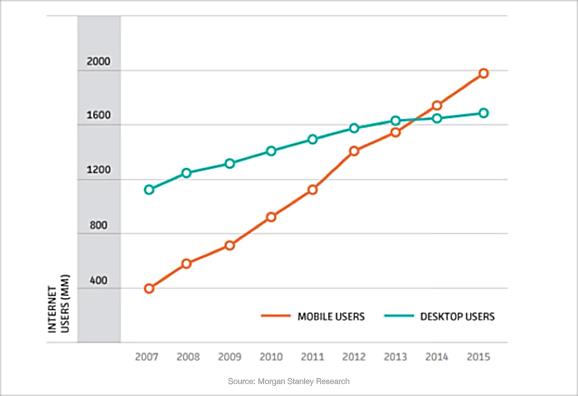
The opportunity for challenger brands
The biggest risk for businesses I’ve observed are the internal stakeholders defending their hard fought for legacy systems and infrastructure, and managers who are obsessed with efficiency through fine-tuning traditional methods. As Kundra points out, competitiveness now comes from letting go of what you’ve currently got now. “Most large scale organisations are still stuck in 1980s technologies. If you’re still stuck in an old mindset then unfortunately there’s a young entrepreneur who is imagining the way the world should be rather than it is.”
“The most amazing opportunities lie in reinventing entire sectors of the economy.” Vivek used the usual examples of US companies like Amazon, Netflix and Uber as businesses that are challenging categories today.
If you are running a business you have a clear choice he says – “do you want to be Amazon or Barnes & Noble?” This isn’t a particularly new view, as a global survey by Boston consulting summed up a couple of years ago, in this world of rapid change the spoils go to the nimble. Still, many managers still don’t seem to be responding.
“There’s a Darwinian spirit to the extinction of those who are holding onto the 1960s ways of doing business.” Vivek states, “not because it’s in the interest of the customer but because it’s easy and it’s because that’s what they know what to do.”
A marketer’s mantra for today: “The customer. The customer. The customer”
This is the biggest differentiator for challenger brands. “Companies that are embracing the third wave of doing business are doing it in the interest of the customer.”
Kundra recognises the fear of change within businesses when he suggests the best way to introduce a change culture is to build a prototype. “I think for too many people the expectations for transformative technologies is that it takes too long, costs too much and they’ve been burned in the past.”
A test and learn approach reduces risk
Last week at the launch of an AGSM Mid-Market program a professor specialising in innovation for business pointed out success today comes from having a portfolio of new initiatives that can be tested quickly in the marketplace. Rather than over researching only one strategy in an attempt to minimise risk, be willing to fail and fail frequently. The chances of some prototypes being winners with the customer will increase the more you try.
As Kundra says, aim to “be relevant and simplify the customers’ or citizens’ lives”.
Read More

The latest statistics on online fashion retail sales, research on the main purchase driver for financial advice and a Californian think tank pricing model all give marketers strong reasons to reconsider Price as a useful tool.
Evidence 1: Online fashion sales prove price not the motivator
No wonder Australian retailers are scared of online stores. British online retailer ASOS recently revealed that Australia is its single largest foreign market — with Australians buying something from the ASOS website every 6 seconds. The latest research from Roy Morgan shows at December 2012, 7.6% of Aussies aged 14+ (or 1,430,000 people) had made an online fashion purchase in any given four weeks — up from 5.7% (1,062,000) one year earlier.
Online fashion-purchasing habits by Australian women by sub-category, 2011-2012
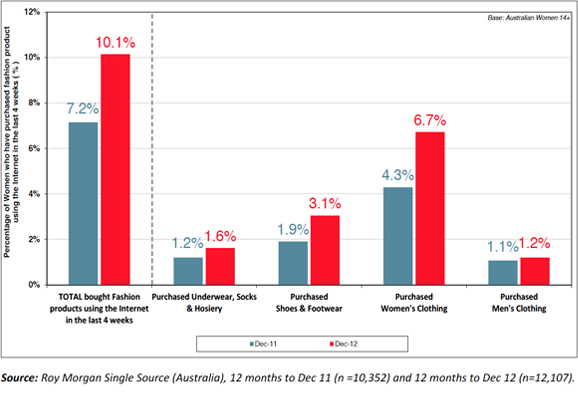
What is really interesting is the opportunities for marketers this research reveals. Most people would probably jump to the conclusion that these online sales are being lost by Australian stores because clothes are available cheaper from overseas. Everything on the web is cheaper, right? Well actually, no.
Roy Morgan’s research has found “scoring a bargain is not the main motivation for women purchasing fashion products online. Far more important is quality, with 75% of them agreeing with the statement ‘I believe quality is more important than price’.”
Discretionary spending by women on clothes has parallels with the way men seek financial advice. A recent national survey by an independent network of financial advisors found the vast majority of customers were more concerned about the quality of service and the frequency of face-to-face time they received than the size of the fee. Of hundreds of customers surveyed, price was rarely mentioned. Value was the primary concern, and the value equation was grounded in the perception of the quality of advice. .
None of this is new. I’ve been segmenting customers using the New Economic Order for nearly two decades since it was first developed by two Australian academics.
Evidence 2: choose who you want to be your customer
You can segment the population by three distinct sets which allow marketers to predict discretionary spending behaviour. The biggest segment, the Traditionals, sre generally cash poor with most of their spending accounted for with essential services, utilities bills, rent, transport and food. They have neither the capacity nor the predisposition to purchase discretionary items.
The other half has a common mindset, they share a desire to buy quality goods and experiences. This group is divided in half by their capacity to spend, one half are NEOs, and while they are only a quarter of the population they represent half all discretionary spending. Transitionals are NEOs on a limited budget: a career couple with one at home with a baby, or a high achiever that's just started their own business, or perhaps they have retired.
For 50% of consumers, the Traditionals, a cheap price is their opening and closing consideration. However these are the people who don’t spend much. They also deliver no sense of loyalty and don’t refer new customers. Every sale to a Traditional is a new sale that starts from scratch. And risks going to the lowest priced competitor on the day.
Most restaurant and airline customers and B2B purchasers are NEOs. These people research purchase decisions on the basis of what they believe are the features and benefits that mean the most to them. Price comes LAST, and isn’t much of a deal breaker.
Those latest stats on online fashion sales make sense in light of NEO behaviour. NEOs are online researching what’s hot in the world of fashion. In fact, it’s where they do most research when considering any major purchase because it’s where they control the levers, avoiding the unsavoury hassle of being sold by a salesman face to face. While Traditionals continue to spend the majority of their clothing budget on essential items like socks and undies in stores when the sales are on, NEOs continue to buy more discretionary fashion items, more often, both from the Internet and instore.
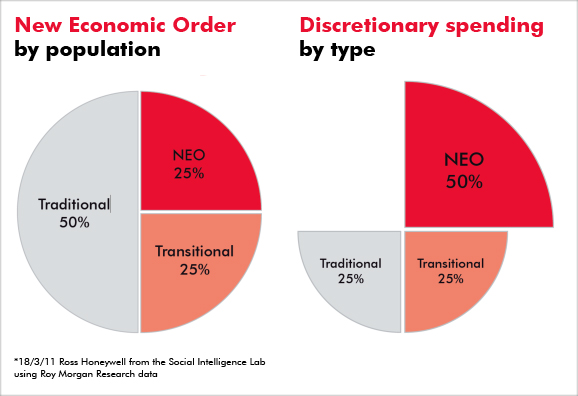
So what’s the best marketing model for selling to NEOs?
Evidence 3: all value is subjective
According to Ron Baker, the founder of Californian think tank the VeraSage Institute there are two fundamental approaches to pricing:
Cost-Plus Pricing
Labour Theory of Value
Product » Cost » Price » Value » Customers
Pricing On Purpose
Subjective Theory of Value
Customers » Value » Price » Cost » Product
You can see how subjective value pricing turns the order of cost-plus pricing on its head, by starting with the ultimate arbiter of value – the customer. In Baker’s words: “Goods and services do not magically become more valuable as they move through the factory and have costs allocated to them by cost accountants. The costs do not determine the price, let alone the value. It is precisely the opposite; that is, the price determines the costs that can be profitably invested in to make a product desirable for the customer, at an acceptable profit for the seller.”
As a marketer, for decades I found software one of the simplest products to approach from the Pricing On Purpose model; it’s the only reason Microsoft had education, standard and professional versions. The mid range product best reflects a fair margin for the cost of production of the product. The same product is then also sold at a low entry price with a few features turned off to maximise sales volume at the low end and repackaged in a fancy big box with a few extra features to maximise margin at the upper end of the market.
Choose who you want your customer to be, only then pick a marketing P
Whether you are selling clothes or cars, fair trade coffee or boutique wine, building materials or investment services, remember when your sales force wants you to discount, ask them to stop and think about the customer. Are you selling a basic product to a student, an authentic experience to a Transitional or a professional service to a NEO? Agree with sales who your customers are before you decide to use the PRICE lever.
Depending on who your customer is, Product, Place or Promotion may be more valuable to them than Price.
Read More

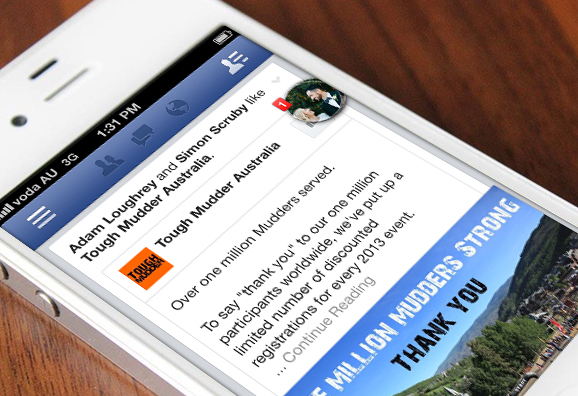
Just being active on Facebook isn’t enough. As with any communications medium, there are smart ways to achieve more for less effort.
Don’t be baffled by social media marketing spin doctors. Sure, Facebook has it’s own set of best practices. Hopefully by getting to know what matters and what doesn’t you can ensure any supplier will make the most of your investment.
The key to making the most of Facebook for your business is understanding it’s all about making sure everything you do improves your chances of being seen.
Much of this isn’t about paying for black art, it’s about basic step by step craft.
40% of time on Facebook is spent on news feeds
Only 12% is spent on profile or brand pages. So:
- Post articles on other people’s pagesPost on less pages more often
- Choose pages with high numbers of fansPhotos have higher ranking than links or text
- Use images
- Keep your text posts short – between 100 to 250 characters get 60% more engagement
- Ask a question
- Post daily and frequently
- Post about relevant topics – don’t push the brand
- Test your audience for their engagement times – 18-24 year olds are most active 9pm – 10pm, women 25-45 even later
How edge-ranking works is the key for marketers
All of these individual steps are only important because of something called edge-ranking. This makes or breaks social media marketing. This infographic shows how it works.
Read MoreThe health checklist for your sales process

15 questions to help your business determine the focus for your sales activity.
Do you have a sales department? Here are 15 questions to help change your sales force from sales takers to sales makers:
- How much time are you investing in new business a day?
- Is the total revenue and the sum of your clients’ budgets growing more slowly than in the past?
- Will growth levels come from present client budgets?
- Where will growth come from?
More frequency of purchase
More volume of each sale
More value? Up sell/or cross sell? - Will growth have to come from new business won from competitors?
- How do you sell to prospective clients?
- What’s your process?
- How do you find them?
- How do you win them?
- How do you prioritise sales calls?
- How is a sales call pre-qualified, (telesales/email/CRM)
- How long is spent face to face?
- What is your conversion rate?
- Is the sales call to the final decision maker?
- Who is the primary decision maker, how are they managed?
ROI marketing can help improve the performance of any of these sales metrics.
Marketing can speed sales, pre-qualify and build loyalty once you’ve made a sale.
In the past business owners were frustrated by an inability to measure what worked and what didn’t. Today there are tools and technques to enable you to measure the return on your marketing investment.
Read More


Scan the QR code for our contact details.
Download the Neoreader app.
© COPYRIGHT 2013 UNO marcomms Privacy